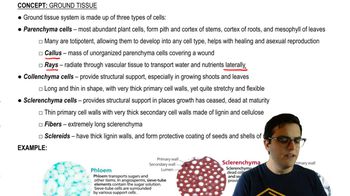Table of contents
- 1. Introduction to Biology2h 42m
- 2. Chemistry3h 40m
- 3. Water1h 26m
- 4. Biomolecules2h 23m
- 5. Cell Components2h 26m
- 6. The Membrane2h 31m
- 7. Energy and Metabolism2h 0m
- 8. Respiration2h 40m
- 9. Photosynthesis2h 49m
- 10. Cell Signaling59m
- 11. Cell Division2h 47m
- 12. Meiosis2h 0m
- 13. Mendelian Genetics4h 44m
- Introduction to Mendel's Experiments7m
- Genotype vs. Phenotype17m
- Punnett Squares13m
- Mendel's Experiments26m
- Mendel's Laws18m
- Monohybrid Crosses19m
- Test Crosses14m
- Dihybrid Crosses20m
- Punnett Square Probability26m
- Incomplete Dominance vs. Codominance20m
- Epistasis7m
- Non-Mendelian Genetics12m
- Pedigrees6m
- Autosomal Inheritance21m
- Sex-Linked Inheritance43m
- X-Inactivation9m
- 14. DNA Synthesis2h 27m
- 15. Gene Expression3h 20m
- 16. Regulation of Expression3h 31m
- Introduction to Regulation of Gene Expression13m
- Prokaryotic Gene Regulation via Operons27m
- The Lac Operon21m
- Glucose's Impact on Lac Operon25m
- The Trp Operon20m
- Review of the Lac Operon & Trp Operon11m
- Introduction to Eukaryotic Gene Regulation9m
- Eukaryotic Chromatin Modifications16m
- Eukaryotic Transcriptional Control22m
- Eukaryotic Post-Transcriptional Regulation28m
- Eukaryotic Post-Translational Regulation13m
- 17. Viruses37m
- 18. Biotechnology2h 58m
- 19. Genomics17m
- 20. Development1h 5m
- 21. Evolution3h 1m
- 22. Evolution of Populations3h 52m
- 23. Speciation1h 37m
- 24. History of Life on Earth2h 6m
- 25. Phylogeny2h 31m
- 26. Prokaryotes4h 59m
- 27. Protists1h 12m
- 28. Plants1h 22m
- 29. Fungi36m
- 30. Overview of Animals34m
- 31. Invertebrates1h 2m
- 32. Vertebrates50m
- 33. Plant Anatomy1h 3m
- 34. Vascular Plant Transport1h 2m
- 35. Soil37m
- 36. Plant Reproduction47m
- 37. Plant Sensation and Response1h 9m
- 38. Animal Form and Function1h 19m
- 39. Digestive System1h 10m
- 40. Circulatory System1h 57m
- 41. Immune System1h 12m
- 42. Osmoregulation and Excretion50m
- 43. Endocrine System1h 4m
- 44. Animal Reproduction1h 2m
- 45. Nervous System1h 55m
- 46. Sensory Systems46m
- 47. Muscle Systems23m
- 48. Ecology3h 11m
- Introduction to Ecology20m
- Biogeography14m
- Earth's Climate Patterns50m
- Introduction to Terrestrial Biomes10m
- Terrestrial Biomes: Near Equator13m
- Terrestrial Biomes: Temperate Regions10m
- Terrestrial Biomes: Northern Regions15m
- Introduction to Aquatic Biomes27m
- Freshwater Aquatic Biomes14m
- Marine Aquatic Biomes13m
- 49. Animal Behavior28m
- 50. Population Ecology3h 41m
- Introduction to Population Ecology28m
- Population Sampling Methods23m
- Life History12m
- Population Demography17m
- Factors Limiting Population Growth14m
- Introduction to Population Growth Models22m
- Linear Population Growth6m
- Exponential Population Growth29m
- Logistic Population Growth32m
- r/K Selection10m
- The Human Population22m
- 51. Community Ecology2h 46m
- Introduction to Community Ecology2m
- Introduction to Community Interactions9m
- Community Interactions: Competition (-/-)38m
- Community Interactions: Exploitation (+/-)23m
- Community Interactions: Mutualism (+/+) & Commensalism (+/0)9m
- Community Structure35m
- Community Dynamics26m
- Geographic Impact on Communities21m
- 52. Ecosystems2h 36m
- 53. Conservation Biology24m
33. Plant Anatomy
Tissues
Problem 2`
Textbook Question
Evaluate the following statements regarding tracheids and vessel elements.
Select True or False for each statement.
T/F Both tracheids and vessel elements are specialized for water conduction.
T/F Both tracheids and vessel elements have pits.
T/F Vessel elements have perforation plates but tracheids do not.
T/F Tracheids and vessel elements have to be alive in order to transport water.
 Verified step by step guidance
Verified step by step guidance1
Understand that tracheids and vessel elements are both types of cells found in the xylem, which is responsible for water conduction in plants.
Recognize that both tracheids and vessel elements have pits, which are small openings that allow water to move between cells.
Learn that vessel elements have perforation plates, which are openings at the ends of the cells that allow for more efficient water flow, while tracheids do not have these plates.
Note that tracheids and vessel elements are dead at maturity, meaning they do not need to be alive to transport water. Their cell walls remain intact to facilitate water movement.
Evaluate each statement based on the information provided: 1) Both tracheids and vessel elements are specialized for water conduction. 2) Both have pits. 3) Vessel elements have perforation plates, tracheids do not. 4) They do not need to be alive to transport water.
 Verified video answer for a similar problem:
Verified video answer for a similar problem:This video solution was recommended by our tutors as helpful for the problem above
Video duration:
1mPlay a video:
Was this helpful?
Key Concepts
Here are the essential concepts you must grasp in order to answer the question correctly.
Water Conduction in Plants
Water conduction in plants is primarily facilitated by xylem tissue, which includes tracheids and vessel elements. These structures are specialized for transporting water and minerals from roots to other parts of the plant. Tracheids are elongated cells that overlap, while vessel elements are shorter and form continuous tubes, both contributing to efficient water movement.
Recommended video:
Guided course

Land Plants
Pits in Xylem Cells
Pits are small openings in the cell walls of xylem cells, including both tracheids and vessel elements. They allow for lateral movement of water between adjacent cells, facilitating efficient water transport throughout the plant. Pits are crucial for maintaining connectivity and flexibility in the plant's vascular system, especially under varying environmental conditions.
Recommended video:
Guided course

How Water Enters Xylem
Perforation Plates
Perforation plates are structures found in vessel elements that allow for direct flow of water between cells. Unlike tracheids, which lack these plates, vessel elements have perforations that reduce resistance and enhance water conduction efficiency. This structural difference is key to understanding the distinct roles and functionalities of tracheids and vessel elements in the xylem.
Recommended video:
Guided course

Plate Tectonics and Continental Drift
Related Videos
Related Practice



















